



Kope
Individual Project
5 Week Timeline - Fall 2018
Tool: Alexa Skill Blueprints, Adobe Illustrator, Adobe Photoshop, G Suite
Kope is an interactive Alexa Skill application which helps preteens cope with their PTSD through education, healing, and growth. Allowing the individual to utilize Alexa as a resource through conversation as a way to understand their mental health.
Question
How can I make a positive impact on the lives of children facing mental illness?
User Need
A way to understand and cope with post-traumatic stress disorder.
Demographic
Preteens, ages 9-11, diagnosed with post-traumatic stress disorder
Ideation
My main inspiration for this came from my personal life and experiences with my own mental health as a child. I was professionally diagnosed with Post-Traumatic Stress Disorder at the age of fourteen, from events that occurred around the ages of five to eight years old.
This lead me to the idea that children need a way to understand and cope with post-traumatic stress disorder, even if they do not have access to traditional therapy.
Research
PTSD & Preteens.
My priority was to get a full grasp on the who, what, when, where, and why’s of PTSD in preteens which was different than in adults, specifically on how children learned about how to cope with their own mental illness.
Current Market & Competitive Landscape.
I heavily researched current apps, activities, chatbots, and PSA initiatives which helped preteens who have faced trauma. I also used my Amazon Echo Dot to see what Alexa knew about PTSD, and its capabilities without any skills.Alexa Skills.
Lastly, I started to narrow in on the most untaped market for this subject: Amazon’s Echo. The Alexa AI on its own, without skills, knew almost nothing about PTSD specifically in preteens. For the Alexa Skills, there were no skills which directly corresponded to my topic. I “interviewed” similar skills to see what they could do, what worked best, and what to avoid. My most important part of this research was determining how to design an Alexa Skill, and how to build a fully functioning prototype.
My brainstorming mindmap of an Alexa Skill.
Why This Solution?
There are currently numerous mental health apps on the market, however they are specifically targeted towards adults or teens. All of these apps have AI capabilities, and AI is a necessary component to having a conversational experience.
The Amazon Alexa has a very small amount of Skills which can be added on for the use of mental health help. The current Alexa Skills are not age based, nor deal with PTSD specifically.
This solution fills the gap for preteens, helping educating younger kids on mental health early on. This age is appropriate to start the discussion, spread awareness, and help kids cope with their own mental health in an environment which is appropriate to their age group.
For many adults who have mental disorders, symptoms were present—but often not recognized or addressed—in childhood and youth. For a young person with symptoms of a mental disorder, the earlier treatment is started, the more effective it can be.
Learning How to Write an Alexa Skill
Prior to this project, I had no knowledge about how to make an Alexa Skill. This was also my first time working on a conversational interface, so I had to make a system of documenting my entire process visually for something verbal. Amazon’s Alexa Skill Blueprint program allowed me to write my Alexa Skill, while creating a fully functioning prototype on my Echo Dot.
Before my first test run, I typed out my copy with a color coded system in Google Drive. I kept track of everything in my process document and implemented this color system throughout. Once I was happy with my copy draft, I inputted the information on the Alexa Skill Blueprint program. Screenshots from the Alexa Skill Blueprint were how I kept track of my skill visually in my process document.
Process document color system for conversational interface.
Screenshot from Alexa Skill Blueprint
Mood & Word Board
My process always includes creating visual inspiration through images and words. This allows me to visualize the direction of my project. I gather content from my research to put these together.
Research Interview
The next step in my process was to conduct an interview with a Seattle non-profit, Art With Heart. This organization deals specifically with children who have gone through traumatic experience and are facing hardship.
Skill Functions
All of my research and interviews influenced the functionality of my Alexa Skill. I broke the functionality down into three main components: Learn, Heal, Grow.
Learn: User can utilize Alexa to learn, understand, and educate themselves about PTSD in preteens.
Heal: User can utilize Alexa as a coping mechanism to heal through conversation and other techniques.
Grow: User can utilize Alexa to *track their growth* and find further resources.
Skill Copy Writing
The copy for the skill is the main component of this project. I went through each function and determined what aspects of conversation would be necessary. Since the Alexa Skill Blueprint is only question and answer format, I had to write the copy to those constraints.
Challenges
Conversation interface limits the design to solely verbal communication. The challenges associated with this include the countless ways one person can ask the same question. I dealt with the countless errors, when writing the copy into the blueprint developer. The biggest challenge was to be age appropriate. I utilized advice from the non-profit I interviewed to gain insight on how to best approach some difficult topics.
Branding
For the Skill to have presence in the Alexa Skill app marketplace, it will need a logo and some type of branding. All Alexa Skill icons are displayed in their circle template, and must fit in the circle, which is something to keep in mind while coming up with logo ideas.
The name Kope was the ultimate winner, due to its ability to highlight the primary function of the skill. I choose to write Kope phonetically as an emphasis of the preteen aspect of the project, giving it a friendly personality.
Amazon Alexa App
In order to access any skill, you must enable them from the Alexa App which is connected to the Echo device. I designed mockups with the user interface to give a portrayal of what Kope would look like in the app.
Kope in Conversation
I made many visuals in my process in order to be able to present my conversational interface in a digestible format. You can play here to listen to Kope in action, displaying some key functions of the skill.
Final Thoughts
This project challenged me to push myself out of my comfort zone and take risks. I learned how to design an Alexa Skill within time and resource constraints.
If given more time, I would like to design an Alexa Skill which is developed by a whole team. Instead of using the Skill Blueprint, the team would program their own AI chatbot, instead of the traditional Q&A format. We would also conduct user testing with the preteen demographic for accuracy and further refinement feedback on the functionality.





















